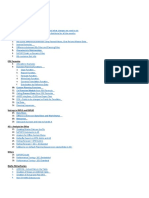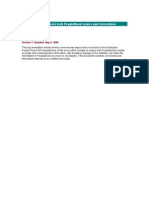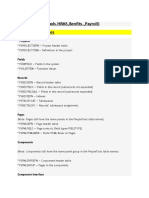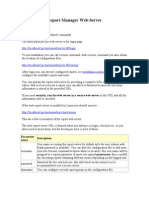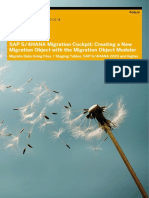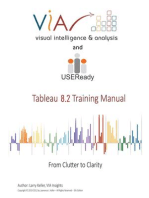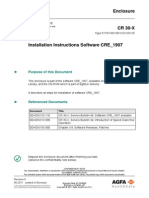Change Document3a Step by Step
Change Document3a Step by Step
Uploaded by
wysoki1982Copyright:
Available Formats
Change Document3a Step by Step
Change Document3a Step by Step
Uploaded by
wysoki1982Copyright
Available Formats
Share this document
Did you find this document useful?
Is this content inappropriate?
Copyright:
Available Formats
Change Document3a Step by Step
Change Document3a Step by Step
Uploaded by
wysoki1982Copyright:
Available Formats
ABAP: Change Document
Applies to:
This document applies to SAP ECC 6.0, SAP Netweaver 2004s. For more information, visit the ABAP homepage.
Summary
This article contains the step by step procedure to guide you to make change log entries in CDHDR and CDPOS tables in SAP ECC 6.0 version. The requirement is to enter change log entries for custom tables. Author: Rahul Muraleedharan
Company: Applexus Software Solutions (P) Ltd Created on: 22 September 2010
Author Bio
Rahul Muraleedharan is working as SAP Technology Consultant with Applexus Software Solutions (P) Ltd. He has an experience of over 1 year in SAP ABAP.
SAP COMMUNITY NETWORK 2010 SAP AG
SDN - sdn.sap.com | BPX - bpx.sap.com | BOC - boc.sap.com | UAC - uac.sap.com 1
ABAP: Change Document
Table of Contents
Introduction ......................................................................................................................................................... 3 Steps for creating change log entries: ............................................................................................................ 3 Step by Step Process ......................................................................................................................................... 4 Related Content ................................................................................................................................................ 14 Disclaimer and Liability Notice .......................................................................................................................... 15
SAP COMMUNITY NETWORK 2010 SAP AG
SDN - sdn.sap.com | BPX - bpx.sap.com | BOC - boc.sap.com | UAC - uac.sap.com 2
ABAP: Change Document
Introduction
In a transaction a lot of database updates will occur. It will be very useful if we are able to trace the changes made. For this purpose we can make use of the change document tables viz., CDHDR and CDPOS. The change log entries in Change Document tables can be either actual changes or planned changes. Steps for creating change log entries: 1. Create an object class. 2. Set the change document flag. 3. Include the R3TR generated include files in the program. 4. Call the R3TR generated update function module where the database table is getting updated. 5. Pass the initial values of the records which are getting updated in the database table to the update function module. 6. Pass the new values of the records to the update function module.
SAP COMMUNITY NETWORK 2010 SAP AG
SDN - sdn.sap.com | BPX - bpx.sap.com | BOC - boc.sap.com | UAC - uac.sap.com 3
ABAP: Change Document
Step by Step Process
1. Go to the transaction SCDO for creating an object class. All the tables should be included in an object class in order to log the data changes in the change document tables.
A popup will be displayed asking the namespace and the name of the object class to be created.
Namespace is an optional field but the name of the object class is a mandatory field. Enter a suitable name for the object class starting with Z and press CONTINUE. If you dont enter the namespace then a warning message will be shown as a popup, press YES.
SAP COMMUNITY NETWORK 2010 SAP AG
SDN - sdn.sap.com | BPX - bpx.sap.com | BOC - boc.sap.com | UAC - uac.sap.com 4
ABAP: Change Document
2. A new popup will be displayed. Here you have to give the following details: a) A short text for the change document object. b) Name of the database tables to be included in the object class whose data changes are to be logged. c) The check box for Copy as internal tab. has to be checked if multiple records of the database table will be updated at the same time (multiple case). d) The check box for Doc. for individual fields at delete has to be check ed if we want separate log entry for each field when a particular(s) record is deleted. e) If the currency and unit fields are defined in a reference table, rather than in the table passed, you must pass the name of the reference table, and the field referred to, to the function module. Create an INTTAB structure in the Dictionary, and define fields for this structure, which are made up of the names of the associated reference table and the reference fields. Enter the name of this structure in the field for Name of ref. tab. f) The field for Name of the old record fields has significance only if we havent checked the checkbox for Copy as internal tab.. Even then this field is optional. If its not filled then the name of the work area which holds the old record will have the name *work area otherwise the name the name which we have specified in that field. After filling all the fields required press INSERT ENTRIES.
Here ZRH_FLIGHT is the database table for which the data changes are to be logged. All other fields are optional and it can be set according to the requirement. Here one record will be updated to the database table at a single time. If we are updating the table through an internal table then the checkbox for Copy as internal tab. has to be checked.
Note: We can include more than one database table in a single change doc object
SAP COMMUNITY NETWORK 2010 SAP AG
SDN - sdn.sap.com | BPX - bpx.sap.com | BOC - boc.sap.com | UAC - uac.sap.com 5
ABAP: Change Document
3. Now we should decide for which all fields in the database tables we require the log entries. And the change document flag for the corresponding data elements have to be checked. The change document property is to be set in the further Characteristics tab of the data element.
SAP COMMUNITY NETWORK 2010 SAP AG
SDN - sdn.sap.com | BPX - bpx.sap.com | BOC - boc.sap.com | UAC - uac.sap.com 6
ABAP: Change Document
4. Now the change doc object is to be saved.
5. Go to the Utilities in the menu bar. Select GENERATE UPDATE PGM. A pop up will be displayed saying that the change doc object is not in your namespace if you have not specified it in the initial screen. Press YES. Now a dialog box will be displayed.
Here you have to enter: a) Include Name (Maximum 26 character): This name is used to complete the name of the R3TR generated INCLUDE programs.
SAP COMMUNITY NETWORK 2010 SAP AG
SDN - sdn.sap.com | BPX - bpx.sap.com | BOC - boc.sap.com | UAC - uac.sap.com 7
ABAP: Change Document
b) Function group: Enter the name of the function group to which the change document update program is to belong. If this function group does not yet exist in the system, it is automatically created during generation. Exactly one function group must belong to each change document object. Other function modules may not be assigned to this function group. c) Fun.mod. structure prefix: For multiple cases table transfer structures are created at generation. Their names are constructed from the prefix and the name of the table.
Note: Since this will be a parameter to an update function module its length should be longer than 28 characters. So consider the table name when you set the prefix.
d) Error message ID: The application-specific error messages generated are stored under this
message ID (work area). A value is proposed. e) Error Number: Number with which errors occurring in connection with this change document object can be identified in the system. A value is proposed. f) Processing type: The processing type of the function module should be selected from any of the three options viz., Immediate Update, delayed Update, Dialog. g) Special Text handling Flag: This should be checked if long text changes are to be logged. The old and new status of long texts is not logged. Only the fact that they have been changed is noted. h) Generating DATA for OO: This is an alternative for generating data and tables statements for ABAP OO environment. After filling all the required fields press GENERATE.
When you press generate button a pop up will be displayed if the function group that you have Specified is not yet created. Press YES. Now the system will show all the actions that will be carried out for generation.
SAP COMMUNITY NETWORK 2010 SAP AG
SDN - sdn.sap.com | BPX - bpx.sap.com | BOC - boc.sap.com | UAC - uac.sap.com 8
ABAP: Change Document
Press the SAVE button.
SAP COMMUNITY NETWORK 2010 SAP AG
SDN - sdn.sap.com | BPX - bpx.sap.com | BOC - boc.sap.com | UAC - uac.sap.com 9
ABAP: Change Document
All the details of the update program generated are displayed. The INCLUDE program generated are F<include name>DT, F<include name>DF, F<include Name>DV and F<include name>DC. F<include name>DT includes programs F<include name>DF and F<include name>DC. F<include name>DF includes all declaration of all the variables created. F<include name>DV includes all the work areas and internal tables created. F<include name>DC includes the form routine for calling the update function module <Include Name>_WRITE_DOCUMENT. The update function module <Include Name>_WRITE_DOCUMENT calls the following object specific parameters. CHANGEDOCUMENT_OPEN CHANGEDOCUMENT_SINGLE_CASE If single case CHANGEDOCUMENT_MULTIPLE_CASE If multiple case CHANGEDOCUMENT_TEXT_CASE If Special Text handling Flag is set. CHANGEDOCUMENT_CLOSE
SAP COMMUNITY NETWORK 2010 SAP AG
SDN - sdn.sap.com | BPX - bpx.sap.com | BOC - boc.sap.com | UAC - uac.sap.com 10
ABAP: Change Document
6. Include the include program in the custom program. Include all the R3TR generated in the custom program.
And call the subroutine which includes the update function module where the database updation takes place. Before calling the subroutine set all the input parameters for the update function module viz., a) OBJECTID: A parameter to identify a unique record of a table usually all the primary key values are concatenated together and given. b) TCODE: The transaction in which the updation happens. c) UDATE: Change date. d) UTIME: Change time. e) USERNAME: User responsible for the change. f) UPD_<Table Name>: Update Flag (Insert, update or delete). Also the old value and new values have to be passed to the update function module.
Note: Since its an update function module COMMIT WORK should be called after the execution of the function module.
SAP COMMUNITY NETWORK 2010 SAP AG
SDN - sdn.sap.com | BPX - bpx.sap.com | BOC - boc.sap.com | UAC - uac.sap.com 11
ABAP: Change Document
7. Execute the transaction. Sample Scenario: a) Inserting a new record to the flight details table.
On saving the record a new entry will be created in CDHDR and CDPOS tables.
b)On modifying an existing record of the flight details. CDPOS will have new entries. CDHDR will have a single new record.
SAP COMMUNITY NETWORK 2010 SAP AG
SDN - sdn.sap.com | BPX - bpx.sap.com | BOC - boc.sap.com | UAC - uac.sap.com 12
ABAP: Change Document
c) On deleting an existing record. CDPOS and CDHDR will have one more entry.
SAP COMMUNITY NETWORK 2010 SAP AG
SDN - sdn.sap.com | BPX - bpx.sap.com | BOC - boc.sap.com | UAC - uac.sap.com 13
ABAP: Change Document
Related Content
Need to log entries in CDPOS and CDHDR Change Log Change Documents For more information, visit the ABAP homepage.
SAP COMMUNITY NETWORK 2010 SAP AG
SDN - sdn.sap.com | BPX - bpx.sap.com | BOC - boc.sap.com | UAC - uac.sap.com 14
ABAP: Change Document
Disclaimer and Liability Notice
This document may discuss sample coding or other information that does not include SAP official interfaces and therefore is not supported by SAP. Changes made based on this information are not supported and can be overwritten during an upgrade. SAP will not be held liable for any damages caused by using or misusing the information, code or methods suggested in this document, and anyone using these methods does so at his/her own risk. SAP offers no guarantees and assumes no responsibility or liability of any type with respect to the content of this technical article or code sample, including any liability resulting from incompatibility between the content within this document and the materials and services offered by SAP. You agree that you will not hold, or seek to hold, SAP responsible or liable with respect to the content of this document.
SAP COMMUNITY NETWORK 2010 SAP AG
SDN - sdn.sap.com | BPX - bpx.sap.com | BOC - boc.sap.com | UAC - uac.sap.com 15
You might also like
- GRC300 6Document48 pagesGRC300 6vincentdavidNo ratings yet
- Add Customer Field Into Enjoy TransactionsDocument8 pagesAdd Customer Field Into Enjoy Transactionsmnryan100% (1)
- BPC Embedded Interview QuestionsDocument88 pagesBPC Embedded Interview QuestionsSandeep SagarNo ratings yet
- Implement Screen Exit For MM01 - Adding New Fields in ScreenDocument12 pagesImplement Screen Exit For MM01 - Adding New Fields in Screenapi-3708589100% (5)
- AS01 EnhancementDocument6 pagesAS01 EnhancementgopigundetiNo ratings yet
- ETL Development StandardsDocument6 pagesETL Development StandardsvinayaartalaNo ratings yet
- PeopleTools 8.48 Documentation Issues and CorrectionsDocument24 pagesPeopleTools 8.48 Documentation Issues and Correctionsmarlou_mac98No ratings yet
- Change Documents Maintanence For ZTABLES in CDPOS & CDHDRDocument10 pagesChange Documents Maintanence For ZTABLES in CDPOS & CDHDRneil_scribd2012No ratings yet
- Nintex Workflow 2007 SDK 1.1Document214 pagesNintex Workflow 2007 SDK 1.1Farhad JavanmardiNo ratings yet
- 84 Cómo Crear Una User Exit para Activos Fijos ANLUDocument8 pages84 Cómo Crear Una User Exit para Activos Fijos ANLUPedro Francisco GomezNo ratings yet
- Change Document: SDN Community BPX Community Business Analytics University Alliances Sap EcohubDocument6 pagesChange Document: SDN Community BPX Community Business Analytics University Alliances Sap EcohubHarini KalvakuntlaNo ratings yet
- Steps To Activate ALE Delta For Custom Master Datasource Created On ZTableDocument13 pagesSteps To Activate ALE Delta For Custom Master Datasource Created On ZTableAbdul MalikNo ratings yet
- LSMWDocument7 pagesLSMWPatil MgNo ratings yet
- Nintex Workflow 2007 SDK 1.2Document235 pagesNintex Workflow 2007 SDK 1.2wregweNo ratings yet
- Change Documents by Sap HelpDocument10 pagesChange Documents by Sap Helpakkiraju_pNo ratings yet
- People Tools 8.49 Documentation Issues and Corrections PT849Document25 pagesPeople Tools 8.49 Documentation Issues and Corrections PT849Paul SumerNo ratings yet
- Homogeneous SystemDocument27 pagesHomogeneous SystemSafouane GalaiNo ratings yet
- SRM 4.0 - Supplier Self Services: Customer FieldsDocument35 pagesSRM 4.0 - Supplier Self Services: Customer FieldsrenatopennaNo ratings yet
- OBIEE Metadata DevelopmentDocument10 pagesOBIEE Metadata DevelopmentMukeshBabuNo ratings yet
- Data Uploading in SAPDocument4 pagesData Uploading in SAPnalini saxenaNo ratings yet
- 80312A-ENUS Error LogDocument10 pages80312A-ENUS Error LogSafdar HussainNo ratings yet
- Data Dictionary For DocumentationDocument21 pagesData Dictionary For DocumentationDipeshNo ratings yet
- wnvfp9 sc05Document30 pageswnvfp9 sc05JayakumarBaluNo ratings yet
- HowTo MDGMaMaintenanceforMultiple MaterialsDocument37 pagesHowTo MDGMaMaintenanceforMultiple MaterialsSuraj Shah0% (1)
- Define Table FormDocument2 pagesDefine Table FormSubhasisNo ratings yet
- ABAP Review Check ListDocument7 pagesABAP Review Check Listpal singhNo ratings yet
- Sap Ip Bi File Data LoadDocument25 pagesSap Ip Bi File Data LoadNarla Raghu Sudhakar ReddyNo ratings yet
- SAS/Data Integration Studio - Creating and Using A Generated TransformationDocument10 pagesSAS/Data Integration Studio - Creating and Using A Generated TransformationAdriano CastelhoniNo ratings yet
- Visual Basic 6 Concepts Naming ConventionDocument11 pagesVisual Basic 6 Concepts Naming Conventionferly12No ratings yet
- Roadmap: Take Information Beyond ExcelDocument12 pagesRoadmap: Take Information Beyond ExcelLuis Claudio RamosNo ratings yet
- SAP Note 125776 - Documentation On Transaction BDBG: SymptomDocument6 pagesSAP Note 125776 - Documentation On Transaction BDBG: SymptomkhkiranNo ratings yet
- TSMP3002 - SmartPlant 3D Equipment Reference Data Labs v7Document20 pagesTSMP3002 - SmartPlant 3D Equipment Reference Data Labs v7Shahfaraz Ahmad100% (1)
- IBM DB2 Version 7 Utilities Cool Features and Hot Performance!Document17 pagesIBM DB2 Version 7 Utilities Cool Features and Hot Performance!treasurNo ratings yet
- Extract Programming ConventionsDocument4 pagesExtract Programming Conventionsolecosas4273No ratings yet
- Pre Requisites For DMS Integration With Document CenterDocument6 pagesPre Requisites For DMS Integration With Document CenterRobson MalvaNo ratings yet
- SAP S/4HANA 1909 FPS00 Fully-Activated Appliance: Print Form CustomizationDocument15 pagesSAP S/4HANA 1909 FPS00 Fully-Activated Appliance: Print Form CustomizationProSAP SA de CVNo ratings yet
- SAP S/4HANA 1909 FPS00 Fully-Activated Appliance: Print Form CustomizationDocument15 pagesSAP S/4HANA 1909 FPS00 Fully-Activated Appliance: Print Form CustomizationProSAP SA de CVNo ratings yet
- Which Record Field Property Needs To Be Set To Validate Dates For 30 Days?Document70 pagesWhich Record Field Property Needs To Be Set To Validate Dates For 30 Days?Supriyo ChatterjeeNo ratings yet
- Sedna Reporting FeaturesDocument13 pagesSedna Reporting Featuressorin1970No ratings yet
- Blogs Sap Com 2006-04-19 Ecatt Scripts Creation Non User IntDocument21 pagesBlogs Sap Com 2006-04-19 Ecatt Scripts Creation Non User IntBong LeeNo ratings yet
- Sap Businessobjects Process Control 3.0 Portal Installation Tips and TricksDocument38 pagesSap Businessobjects Process Control 3.0 Portal Installation Tips and TricksHakeem KhanNo ratings yet
- Interview Questions For ABAP On HANADocument7 pagesInterview Questions For ABAP On HANAMadhuMichelNo ratings yet
- ABAP Program StandardsDocument20 pagesABAP Program StandardsSABARI NATHANNo ratings yet
- Visual Basic ReportsDocument16 pagesVisual Basic ReportsCharlemagne Tan DalidaNo ratings yet
- 4generating An Sap Data StructureDocument8 pages4generating An Sap Data StructureSwapna KuntamukkalaNo ratings yet
- Jaspersoft TipsDocument14 pagesJaspersoft TipsEfrainMfNo ratings yet
- Business Suite On HANA and S4HANA Sizing ReportDocument7 pagesBusiness Suite On HANA and S4HANA Sizing ReportTransfer SelfNo ratings yet
- Loading Data From Flat File To Target TableDocument9 pagesLoading Data From Flat File To Target TableAmit Sharma100% (1)
- Oracle Applications - BI - XML Publisher Interview QuestionsDocument5 pagesOracle Applications - BI - XML Publisher Interview QuestionsNavya Sai Krishna B100% (1)
- Hrms Tables AmDocument24 pagesHrms Tables Amsai raoNo ratings yet
- Report ManagerDocument82 pagesReport ManagerjiticaNo ratings yet
- 100 Abap Questions: ABAP Development FAQ Types of ReportsDocument6 pages100 Abap Questions: ABAP Development FAQ Types of ReportsMani KandanNo ratings yet
- SAP S4HANA Migration Cockpit SAP S4HANA 2020 and HigherDocument61 pagesSAP S4HANA Migration Cockpit SAP S4HANA 2020 and HigherNrodriguez0% (1)
- Business Operational Procedures TemplateDocument4 pagesBusiness Operational Procedures Templateziad yousefNo ratings yet
- Problem:: StepsDocument18 pagesProblem:: Stepsvicky_044No ratings yet
- SAP interface programming with RFC and VBA: Edit SAP data with MS AccessFrom EverandSAP interface programming with RFC and VBA: Edit SAP data with MS AccessNo ratings yet
- The Result Is That You Will See Text Based Upon The Color of The Cell in Which You Place This FormulaDocument2 pagesThe Result Is That You Will See Text Based Upon The Color of The Cell in Which You Place This Formulalaurencel_12No ratings yet
- Spring MVC With JdbcTemplate ExampleDocument12 pagesSpring MVC With JdbcTemplate ExampleJordan Ayrtton Ocmin RamirezNo ratings yet
- IDefine - Security ManualDocument34 pagesIDefine - Security ManualMinhQuânNo ratings yet
- MCS 023 PDFDocument76 pagesMCS 023 PDFSukhpreet SinghNo ratings yet
- Hive Is A Data Warehouse Infrastructure Tool To Process Structured Data in HadoopDocument30 pagesHive Is A Data Warehouse Infrastructure Tool To Process Structured Data in HadooparavindNo ratings yet
- Client-Side Vs Server-Side Scripting - 5Document5 pagesClient-Side Vs Server-Side Scripting - 5Fenil Desai100% (6)
- TT 12 Future Computation Cognitive Adaptive Iccgi AdvcompDocument21 pagesTT 12 Future Computation Cognitive Adaptive Iccgi AdvcompGeorge PantelimonNo ratings yet
- Networking in CollegeDocument26 pagesNetworking in CollegepreetvibeNo ratings yet
- Ontologies and Tools: Natalya Fridman Noy Stanford Medical Informatics Stanford UniversityDocument39 pagesOntologies and Tools: Natalya Fridman Noy Stanford Medical Informatics Stanford UniversityLê Anh TuấnNo ratings yet
- Program Design and Algorithm AnalysisDocument50 pagesProgram Design and Algorithm AnalysisKaran RoyNo ratings yet
- M.Tech Computer Science & Technology With Specialization in Computer NetworksDocument15 pagesM.Tech Computer Science & Technology With Specialization in Computer NetworksvsuneelgNo ratings yet
- Synopsis WebRTCDocument6 pagesSynopsis WebRTCPratik KanthiNo ratings yet
- Software EngineeringDocument35 pagesSoftware Engineeringkavya keerthiNo ratings yet
- PgditDocument12 pagesPgditjprernaNo ratings yet
- How To Increase Auto Extend Size of Auto Extend DatafilesDocument8 pagesHow To Increase Auto Extend Size of Auto Extend DatafilesVenkatesh NamalaNo ratings yet
- Synopsis For Online Aptitude TestDocument7 pagesSynopsis For Online Aptitude Testmonya1911100% (4)
- Installation Guide: TPM (Trusted Platform Module)Document20 pagesInstallation Guide: TPM (Trusted Platform Module)sathiyaseelanNo ratings yet
- Memory Management Interview Questions and Answers Guide.: Global GuidelineDocument11 pagesMemory Management Interview Questions and Answers Guide.: Global GuidelineBhavesh ThakkarNo ratings yet
- Labview State Machine Architectures: Presented by Scott Sirrine Eaton CorporationDocument12 pagesLabview State Machine Architectures: Presented by Scott Sirrine Eaton CorporationAlexa CruzNo ratings yet
- Sprs717f - TI AM335x DatasheetDocument236 pagesSprs717f - TI AM335x DatasheetjuampicNo ratings yet
- RubikDocument3 pagesRubikanandakhapaNo ratings yet
- FChapter 2 - Intro To MC68000Document26 pagesFChapter 2 - Intro To MC68000Zyzerull SaadNo ratings yet
- Assignment 8 Yash TiwariDocument22 pagesAssignment 8 Yash TiwariRajat SinghNo ratings yet
- Dairy Management SystemDocument69 pagesDairy Management SystemShashank MahatoNo ratings yet
- UNYOUG Exadata NiemiecDocument178 pagesUNYOUG Exadata NiemiecasifanwNo ratings yet
- Cola PDFDocument85 pagesCola PDFanon_43328084No ratings yet
- Installation Instructions SW CRE - 1907Document21 pagesInstallation Instructions SW CRE - 1907КасымКаташов100% (1)
- SVM Data ImputationDocument6 pagesSVM Data ImputationTresna MaulanaNo ratings yet
- Boutique Management SystemDocument4 pagesBoutique Management SystemPrasanna D100% (1)
- Uvm-Registers Tfitzpatrick PDFDocument47 pagesUvm-Registers Tfitzpatrick PDFmanchuricoNo ratings yet


